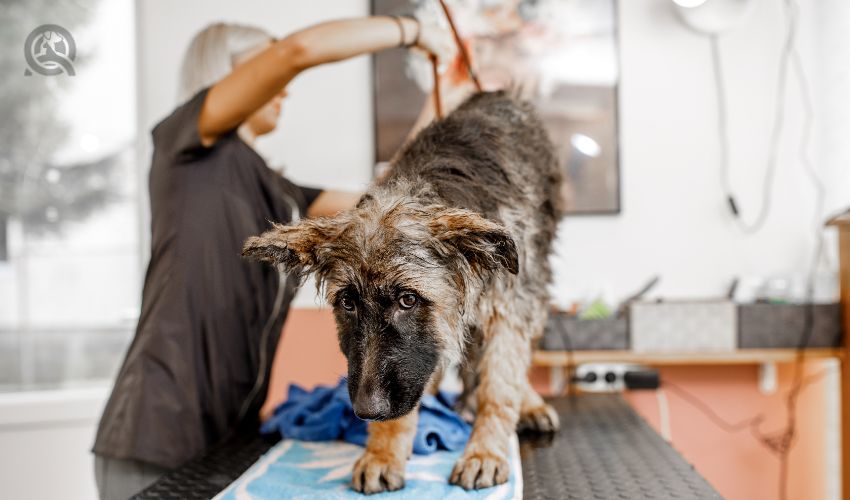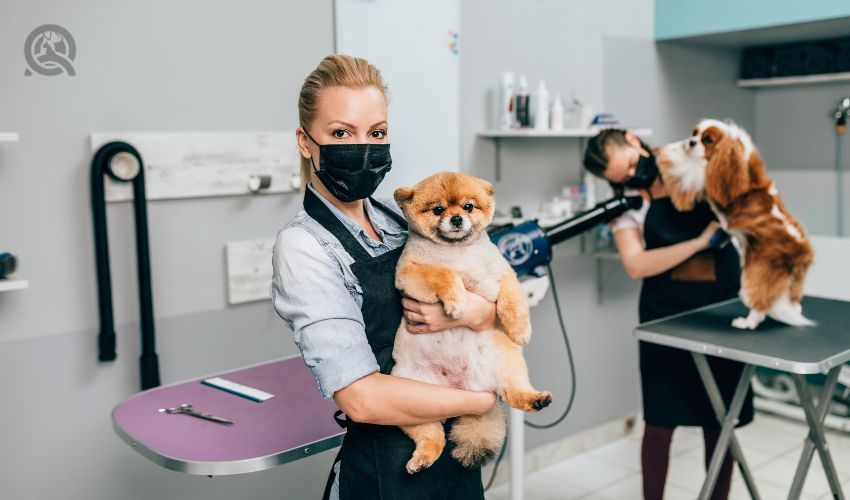If you’re reading this article, it’s because you either dream of becoming a dog groomer or you already are one. Either way, welcome! As a groomer, there’s a lot of valuable information you should acquire in order to do your job properly. One such thing you might have heard about (and want to better understand) is the dreaded “groomers lung”.
We won’t lie – this topic is a little dark. But it doesn’t need to be nearly as scary as the name sounds! Yes, groomers lung is a serious issue. If you want to work in this industry, it is something to be mindful of. However, so long as you know what it is and how to prevent it, you’re going to be fine, trust us!
What is Groomers Lung?
As a grooming professional, your job will often involve shaving, trimming, and cutting dogs’ hair. Moreover, you’ll be working with a lot of products, such as shampoos, conditioners, medicated treatments, etc. A lot of the time, debris winds up floating in the air around you. If you’re not careful, you can inhale it directly into your lungs… which is not good, especially over time.
In a nutshell, groomers lung is a chronic condition that can negatively impact the function of your lungs. It goes without saying that having any foreign object inside of your lungs is not exactly a good thing. Hair, dander, and chemical products are all things that definitely shouldn’t be ingested into our bodies. Not to mention that all of those sharp, tiny hairs can also cause inflammation and create scar tissue.

Can You Die from Groomers Lung?
Of course, having harmful debris in your lungs for a prolonged period of time can eventually become detrimental to your health. That being said, while groomers lung can be fatal in the most extreme cases, the chances of this happening to you are slim.
With that being said, symptoms can range from mild to severe and include:
- Chronic coughing
- Chest pain
- Airway inflammation
- Lung-related issues (i.e. pneumonia, bronchitis, etc.)
- Difficulty breathing
While none of these symptoms sound pleasant, most are manageable and non-fatal. Of course, some of the others (such as lung-related issues and severe difficulty breathing) can admittedly spiral into grievous situations if left unmanaged.
Arguably the worst part of groomers lung is that once you get it, you’ll likely feel its affects for the rest of your life. Furthermore, there’s no known “cure”. This is why it’s important that you take preventative measures throughout your dog grooming career, in order to ensure it never comes to this!
How to Prevent It
Tip #1: Wear a face mask!
Thanks to the COVID pandemic, we’ve all gotten accustomed to wearing face masks as part of our day-to-day lives. Hopefully, in the near future, they won’t be necessary anymore… at least, in your regular life. When on the job, however, a face mask should be a staple part of your work attire!
No, you don’t need to wear it during the entire groom. But at the very least, make sure to wear one whenever you’re handling chemical products or tending to a dog’s hair. Having something to protect your mouth and nose will help reduce the amount of debris in the air from making its way into your lungs.
PRO TIP: Don’t use a face shield, as this will still leave enough space between your face and the shield for hair and debris to sneak its way in. Instead, wear a cloth mask that fits lightly and comfortably to the form of your face. This blog article by John Hopkins Medicine provides some excellent tips to help you buy the right face mask for your needs!

Tip #2: Keep your work station sanitary!
Being clean and sanitary is already a must as a professional dog groomer. Of course, one reason is that it will help make a good impression with your clients. Another is that a clean station will make your job easier, since you’ll never have to scramble to find the tool you need. The most important reason, however, is that a clean space helps ensure the safety of both you and the dogs.
When it comes to preventing groomers lung, a tidy station will go a long way. After every groom, thoroughly and properly clean the area. This includes wiping down surfaces, as well as sweeping and vacuuming floors. Doing so will help reduce the amount of flyaway fur and dander lingering about. Oh, and don’t forget to wear that face mask we talked about while you do your cleaning!
Another smart idea is to invest in an air purifier for your grooming station. Last but not least, ensure that wherever you’re working is properly ventilated. The more you can get clean air circulating through the room, the better!
Tip #3: Be aware of what’s happening around you!
It can be all too easy to get lost in the grooming process and forget to pay attention to what’s happening all around you. But as you’re clipping little Fluffy’s coat, hair could be flying up around your face without you even noticing. This is why it’s important to properly see your surroundings while working on your client’s pooch.
Here are a few quick tips to help with this:
- Wear darker clothing so you can more easily see flyaway hairs. White and/or brighter colors can mask dog hair, making it harder for you to gauge just how much shedding is actually going on.
- Keep your work area bright. Never work in a dimly lit environment. Not only is this unsafe in general – you won’t be able to properly see all of the hair/dander/chemical debris in the air or on the surfaces around you.
- If you run your own business, invest in cool colors for your countertops, grooming tables, etc. Just like with your clothing, cooler and/or darker tones throughout your grooming station will help you spot hair and debris with greater ease.
Tip #4: Educate your clients about at-home care!
If your client never bothers to brush their dog at home in-between appointments, that dog is going to shed a lot more fur whenever they’re in your care. As a result, there’ll be considerably more hair on your work surfaces, the floor, your clothes, and in the air.
As the subject-matter expert, you can help prevent this from happening! Take the time to chat with your client and learn more about the sort of at-home care they give their pup. If there’s room for improvement, gently and respectfully offer some suggestions to guide them in the right direction.
This will definitely help reduce the likelihood of groomers lung!

Tip #5: Get professional dog grooming training!
“Umm… How is professional training supposed to help prevent groomers lung?”
Just stick with me on this for a moment!
When you get trained in a professional certification course, one of the many things you’ll be taught is proper sanitization and safety measures. As a result, you’ll better understand how to clean your products, tools, and work station. This, in turn, will help prevent groomers lung by reducing the amount of fur and dander polluting your work environment (see Tip #2).
Of course, this is just one of many reasons why getting professional training is a smart career move! 😉 If you’d like to learn more about how proper training will make your career all the more successful, check out this blog article here.
What to Do if You Get Groomers Lung
By taking all of the preventative measures outlined in this article, your chances of getting groomers lung will be drastically reduced. However, in the event that you do still contract it, take assurance in knowing that you have options at your disposal.
A doctor will be able to formally diagnose you and offer possible treatments. Depending on the severity, you may be prescribed medications in order to combat the inflammation and reduce pain/discomfort. In more serious cases, immunotherapy may be recommended as well.




